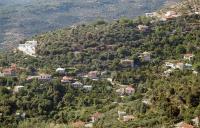 Elaiohori Here we have municipal departments which are nestled in the western slopes of the Mount Taygetos and which stand out for their natural beauty and traditional character. The villages can be reached via the Kalamata - Sparta road and are ideal for those interested in religious history and architecture, walking or simply enjoying nature. 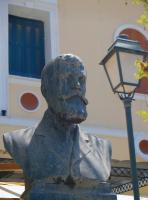 The bust
of Nikolaos
Politis Elaiohori, Dimiovia Monastery
Moving northeast of Kalamata, uphill towards Sparta, brings us to Mount Taygetos. A small detour to the right (east) 5 kilometers outside Kalamata, takes us to Elaiohori and the Monastery of Dimiovia. 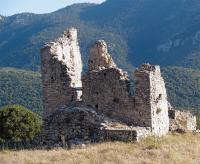 The “Rigas’
Tower” Elaiohori (also known as Yiannitsa), where the celebrated folklorist Nikolaos Politis was born, is known as the “balcony of Kalamata.” It includes the village of 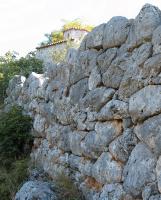 The
Cyclopean
fortification Perivolakia, while just north of it is an area known as Dikalo, which boasts medieval churches that serve to underscore the region’s rich history. Southwest of the Dimiovia Monastery’s grounds is a tower known as “Rigas’ Tower”. Waters and natural springs, the spring of Aghios Vasileios and beautiful fruit-bearing trees compose the landscape of Elaiohori. The remains of a large Cyclopean fortification wall from either the Mycenaean or Hellenistic period, can be seen just outside Elaiohori, near the chapel of Aghion Theodoron, which probably once served as the main church of a 17th century monastery. Ancient relics have also been found in the village cemetery, while clay devotional idols from the Early 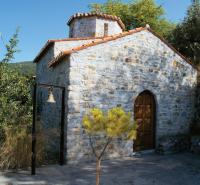 the
chapel of
Aghi
Theodori Classical years, obviously votive offerings, have also been found in a cave in Dimiova. 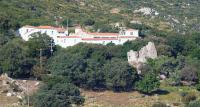 The Monastery
of Dimiova Worth noting while walking around the village are the churches of Aghios Georgios (southeast of the village, it is in ruins), Aghios Athanasios (with fragments of 18th century murals), Zoodochou Pigis and Aghios Dimitrios. 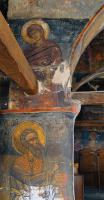 Murals from Dimiova’s Monastery, works
of the monk Damaskinos Scrambled onto the western slope of Mount Taygetos, east of Kalamata, is the Monastery of Dimiova, nestled in magical surroundings of firs and pines, and affording a wonderful view of the surrounding countryside. The building in which the monastery is housed today is dated to the late 16th or early 17th century. 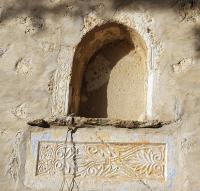 View of the
church of
Aghia Triada
and its
surrounding
area The katholikon (main church) is dedicated to the Dormition of the Virgin. It is a cross-shaped building with a round dome, straight entablature and a semi-circular apse on its eastern side. The inner and outer parts of the dome are decorated with a serrated band, while an inscription over the entrance places the foundation of the monastery at 1663. The church is adorned with murals, the work of the late priest and monk Damaskinos, while it also has an impressive 18th century woodsculpted chancel. 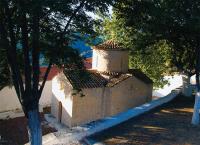 Views of the
church of
Aghia Triada
and its
surrounding
area The history of the monastery is linked to events of great historical importance such as the Orloff uprising of 1770, during which it suffered extensive damage, and the 1821 Greek War of Independence, during which it served as a meeting point for Greek resistance leaders. 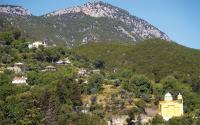 Karveli and
the church of
Eisodeion tis
Theotokou In 1960 the monastery was made a convent, while its present form is the result of construction work carried out over the past few years. 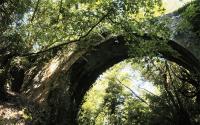 The single-arched bridge
between Karveli
and Ladas A dependency of the Dimiova Monastery, the Church of Aghia Triada is an interesting katholikon of a small monastery, built in a cross shape with a round dome and a three-sided apse on the east. A section of a mid-Byzantine sculpture is embedded into its wall, while the walls are adorned with 18th century murals and there are ruins of old cells outside. 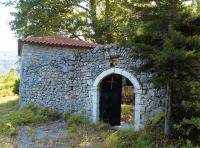 The Monastery
of the
Dormition
of the Virgin,
or Sideroporta
(iron gate) 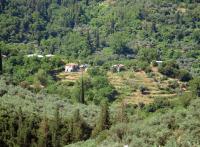 The hamlet
of Emialon Karveli, Ladas, Sideroporta
A second detour to the right (east) some 15 kilometers off the Kalamata-Sparta road, brings us to the villages of Karveli and Ladas, as well as to the Monastery of Sideroporta. They are all located in a mountain valley that is crossed by the Karveliotiko stream, a branch of the Nedon River. Between Karveli and Ladas, at an especially attractive spot, there is a single-arched bridge that is dated to prerevolutionary times. 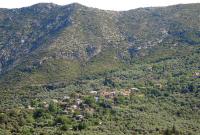 Ladas At Karveli (also known as Koutsava Karveli) take note of the churches of Aghios Ioannis (Kato Karveli, 19th century) and Eisodeion tis Theotokou (19th century), which is remarkable for its bright colors and for an architectural style similar to the Laconian churches of the same period. It is also worth taking a walk down the path leading from Kato Karveli to Ladas. 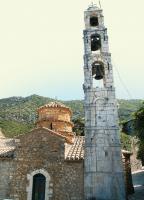 Τhe Church of Taxiarches in Ladas Above Karveli, at an altitude of 700 meters, lies the Monastery of the Dormition of the Virgin, or Sideroporta (iron gate). The compound, whose cells are still very high, was dubbed Sideroporta because of an iron gate donated to it by Parthenios Psomas in 1623. The katholikon, built in 1586, is a single- vaulted domed church with a semicircular apse at the east. The dome has eight sides and a straight entablature. 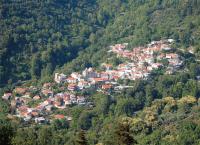 Nedousa Across from Karveli, we come across the hamlet of Emialon, which retains several traces of age-old settlements and also has a small chapel, that of Osios (a lesser saint) Nikon. Ladas, which holds a festival annually in August, is also located in this area. 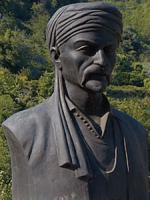 The bust of Nikitaras in Nedousa One of the most striking features of this village is the Church of Taxiarches (Archangels). An impressive bell tower overshadows the southeastern side of the church, while on the inside there are several murals of interest as well as wood-sculpted chancel from the 18th century. Of interest are also the churches of Aghios Vasilios (at the village square, 1783), Aghios Nikolaos, Aghios Athanasios (at the southwestern tip of the village, 18th century) and the Church of Panaghia (Virgin) Kourtsinis (some old cells of which can still be seen on the property). 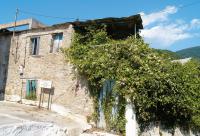 the house of Nikitaras in Nedousa In this area we can also see the katholikon of the old monastery of Zoodochos Pigis and discern the two phases of its construction. Based on morphological evidence that resembles the local folk architecture, the church can be dated to the late 19th century. 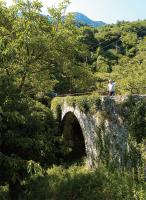 The stone
bridge in
Nedousa 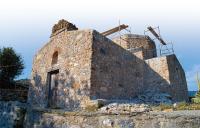 The katholikon
of the Mandraki
Monastery Nedousa
At approximately the 19th kilometer, the Kalamata -Sparta road improves and heads in southeasterly direction. Here there is a detour that leads northeast to Nedousa (or Megali Anastasova). 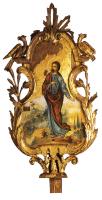 Pair of lypera.
Katholikon of
the Mardaki
Monastery,
early 19th c. Among the highlights of this lovely village are the Church of Aghia Ekaterini, which features neoclassical elements (early 19th century), the Theodorakea watermill, the site of Lagou Hani and the residence and bust of the revolutionary fighter Nikitas Stamatelopoulos, otherwise known as Nikitaras the “Turk Eater.” 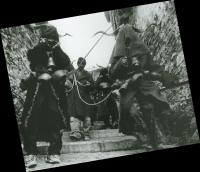 The traditional Nedousa Carnival At the entrance to Nedousa we come across a high, single- arched stone bridge (the arch is 12 meters wide and 22 meters high), which is flanked by two stone water mills. There are a number of stone bridges in the area. 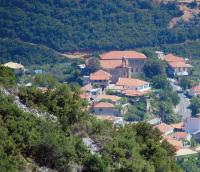 Artemisia Approximately one hour’s drive out of the village, on the western slopes of Mount Taygetos, lies the Mandraki Monastery, where the ground was broken with a cross sent by the Patriarch rather than the usual custom of laying down a foundation stone, and today is a dependency of the Velanidia Monastery. Among the existing remnants is the katholikon, which is dedicated to the Dormition of the Virgin, while there is also evidence of old cells around it and an impressive well. 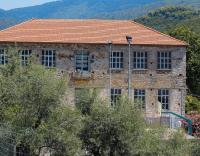 Τhe
art gallery
in Artemisia The katholikon, which still contains a number of early 17th century murals, is in the typical cross-shaped, eightsided dome style. It too has a triple apse at the east, while on the eastern wall of the narthex, directly above the entrance that leads to the main chamber, there is an inscription attesting to the date of its foundation. 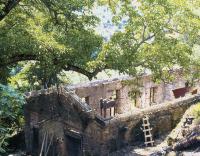 The Rentifi water mill The traditional Nedousa Carnival, held on Clean Monday, is considered one of the most important events of the season in Greece, though it was not known throughout the country until 1995. The stars of the event are men dressed as goats, with large cowbells hung around their necks. The rituals of the carnival include a simulation of harvesting and sowing, a motif of death and life (as if someone who has died is resurrected) and a joyous, as it has evolved today, reenactment of a wedding service. This is all accompanied by dances, satirical songs and risquι innuendo. 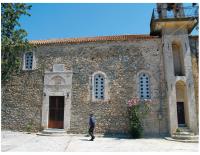 The
basilica of
Ypapanti
Sotiros 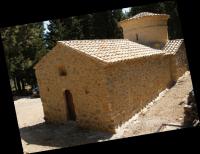 Τhe church
of Timios
Prodromos Piges, Alagonia 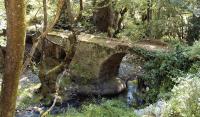 Τhe
Matzinia
bridge Driving out of Artemisa along a road of rare natural beauty that weaves through the verdant landscape of plane, olive and chestnut trees, past springs and creeks, takes us to Piges (Springs) and Alagonia. 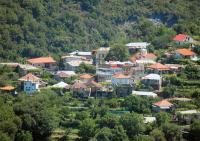 Piges The village of Piges (also known as Mikri Anastasova, 2 km after the junction), which also has a very good sports arena (at Kerasoulia), is distinctive for the modernist Church of Aghi Apostoli (Holy Apostles) located at the village spring, which used to serve as the katholikon of a late 17th century monastery. Other noteworthy churches in the area are those of Aghia Varvara (which has a chancel from 1721), Koimisis tis Theotokou (with 18th century murals), Metamorfosis tou Sotiros (with 19th century murals) and the Church of the Taxiarches. 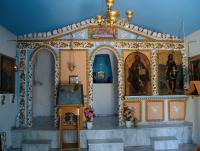 Metamorfosi
tou Sotiros Alagonia (Sitsova), located 3 kilometers further down the road from Piges, is a mountain village built amphitheatrically on the slopes of Mount Taygetos (at an altitude of 750 meters), spreading out at a 1 kilometer radius into the surrounding woods of firs, pines and plane trees and running waters (30 km from Kalamata). The village gets its name from the ancient city of Alagonia, one of the cities in the Commonwealth of Free Laconians, but also after the nymph Alagonia, daughter of Zeus and Europa. 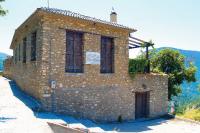 Pelekasis
residence Places of interest in this lovely little village include the residence of Patriarch Prokopios Pelekasis, as well as the Nika Spring (at Louka), which is just outside the village at an exceptionally beautiful spot with large boulders, lofty plane –trees, a creek and a waterfall. 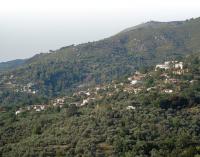 Alagonia There are also several churches of interest: Aghios Nikolaos, at the main square, whose initial phase is dated to the 13th century and which has 17th and 18th century icons inside; Aghia Marina, which dates to the late 13th or early 14th century; Aghios Nikolaos at Kato Meria, a 17th-18th century church; Aghios Sozon, which is a threevaulted basilica southwest of the main square and whose origins date to the 9th-10th century; Aghios Antonios, a cemetery church; Evangelistria, which has 18th century murals; and also Aghios Athanasios, Profitis Ilias, Ypapanti tou Sotiros and Eisodion tis Theotokou (at Mesorouga). 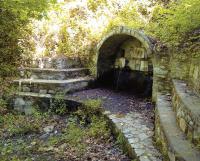 the Nika
Spring Alagonia is also where the Mount Taygetos Visitors Center is located, while every August the village holds its annual potato festival with locals serving a variety of potato-based delicacies to visitors. 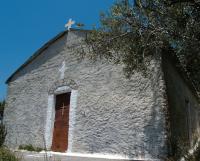 Evangelistria 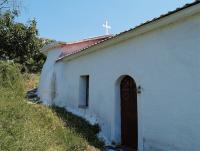 Aghios Sozon |